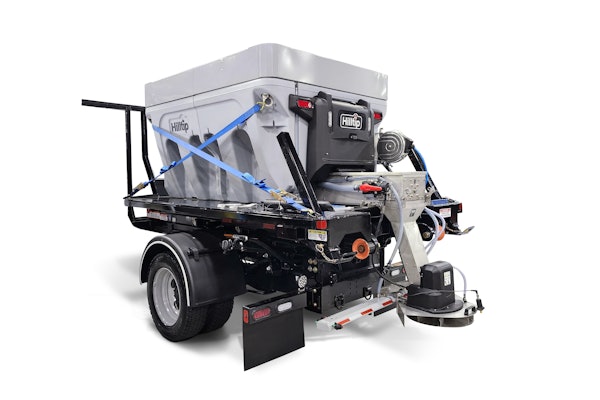One common mistake many beginning landscapers make when it comes to purchasing fertilizer spreaders is opting for consumer-grade products, says Tom Zinninger, proprietor of ZinCo Marketing, which represents PrizeLawn Spreaders. “Don’t think you can go to one of the home supply stores, spend $29.95 for a spreader and expect it to last in commercial landscaping applications,” he cautions. “It’s just not going to work. If you’re serious about your landscaping business, you need to invest a little more money in this than a homeowner does for a spreader he may use once or twice a year.”
If you’re like most beginning landscapers, then you’ll opt for a manual (or push) spreader instead of powered units. And when considering commercial-grade push spreaders, Zinninger says you should remember that there are two basic types available based on the features they offer operators. “The first kind is the premium type machine with all the bells and whistles you can imagine,” he says. “Those are designed and marketed for golf course maintenance applications. You’re probably going to want a fairly plain, simple and easy-to-use unit.”
“Most golf course specific spreaders have three small holes for the fertilizer to flow through,” says Cecil Johns, product manager, controlled release fertilizers for Scotts. “That’s due to the small size of the fertilizer used (SGN150) on golf courses. Landscape spreaders, on the other hand, use larger sized fertilizer (SGN220 to 260) and have a larger single port that enable them to administer the product efficiently. So if you use landscaper fertilizer in a golf course machine, there is a strong possibility you’re going to clog it up.”
Since spreaders deal with corrosive materials and will be used extensively during peak fertilization times, it’s a good idea to judge a potential push unit on the durability of its design. Lightweight construction is a plus, as are controls that are easy to reach and manipulate while wearing protective gloves.
Most entry-level machines don’t have control settings beyond application flow adjusters, which are the most straightforward to understand and use. High-end manual push spreaders have more refined spread pattern control systems, which allow you to micro-manage your fertilizer and chemical applications.
“If your application pattern is too heavy or too light on one side, these control systems allow you to even them out quickly and accurately,” Zinninger notes. “Another popular feature on these high-end units are spread pattern width controls.”
Most spreaders, Zinninger explains, put out fertilizer in an area from 18 feet to 20 feet from the center of the spreader. Most units place the chemicals most efficiently inside a 12-foot pattern area (within the larger spread pattern) – which is called the unit’s effective pattern. “But not every place in the world is that wide,” he notes. “So you can really narrow the application radius if need be. Other units have side deflectors, which allow you to put material down near a swimming pool or a flower bed, for example.”
These features, Zinninger says, not only allow you to customize your chemical applications, but save money as well. “If you have the wrong unit, you’re not going to be able to fertilize the edge of a yard effectively and you end up throwing expensive fertilizer into the street,” he adds. “And in addition to hurting your bottom line, the EPA doesn’t look kindly on landscapers pre-emerging streets in neighborhoods.”
Match spreader capacities to average lawn jobs
Once you’ve settled on a spreader you like, you need to choose carrying capacity. The first step is to determine the average size yards you service. Zinninger says he generally assumes a 7,000-square-foot yard is the average spreader application serviced by most landscapers. “For yards of that size, my experience is that a spreader with a 60- to 80-pound (bag-and-a-half) capacity is generally the most efficient,” he says. “A 50-pound capacity unit will typically run out of material in the middle of the second yard. And that’s an efficiency killer because your only choice is to refill, leaving part of the bag to stashed somewhere. Or, you can simply plan on running out in the middle of the yard, and either mark your spot and go back to the truck, or bring the fertilizer to the spreader where you parked it.”
On the other end of the equation, Zinninger feels 100-pound capacity hoppers are simply too big for a day working on 7,000-square-foot lawns and are better suited to larger scale application jobs. “If you’re in the 60- to 80-pound range, you can generally knock out one average size lawn without having to reload the hopper,” he says. “You run a reduced risk of running out of material during the application process, and you better manage the outlay of chemicals. You’re not as likely to apply too much early in the day.”







